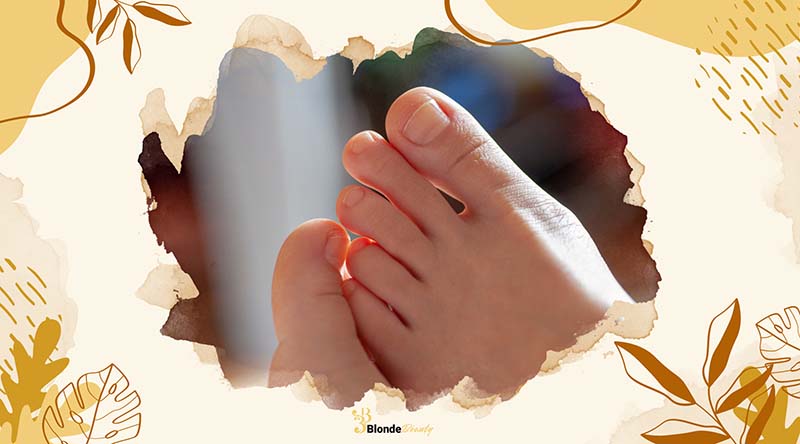Are you noticing little or prominent white spots on your nails? If yes, you might be dealing with a condition known as Leukonychia. Leukonychia is a nail disorder characterized by the partial or complete whitening of the nail.
It can stem from hereditary factors or underlying systemic issues. Many individuals are puzzled by its intermittent appearance and disappearance as their nails grow, and they often inquire about its causes and possible treatments.
In this discussion, we’ll explore the root causes of Leukonychia and explore available treatment options, focusing specifically on the white spot on toe nail.
You should also read the following articles:
- Green Fungus Under Acrylic Nail: Treatment Guide.
- Essential Oils for Nail Fungus: Natural Solution for Healthy Nails.
What Disease Is Leukonychia?
Leukonychia is a prevalent condition characterized by the development of white spots or streaks on the fingernails or toenails.
The term originates from the Greek words “leuko,” meaning “white,” and “onyx,” meaning “nail.” It’s often colloquially referred to as “white spots” or “lines” on the nails.

How Many Types of Leukonychia Are There?
Leukonychia is categorized into two main types:
- True leukonychia: This type originates from the nail matrix, which is responsible for nail production.
- Apparent leukonychia: This condition affects the nail bed beneath the nail, rather than the nail itself.
Further classification of true leukonychia includes:
- Total leukonychia: Characterized by the complete whitening of the nail plate, typically affecting all 20 nails.
- Partial leukonychia: Involves the whitening of a portion of the nail plate, which may affect one nail, several nails, or all nails.
What Does Leukonychia Look Like?
Leukonychia manifests differently for different individuals. Some may notice tiny dot-like white spots scattered across the nail, while others may observe larger spots that extend across the entire nail plate. These spots can affect one nail or multiple nails.
Partial leukonychia can present as:
- Tiny pen-point-sized dots, known as punctate leukonychia, which is a prevalent form.
- Larger lines running longitudinally across the nail, referred to as longitudinal leukonychia.
- Larger individual dots or horizontal bands parallel to the nail base, identified as striate or transverse leukonychia.

Causes of Leukonychia
The causes of leukonychia can vary, ranging from nail trauma to underlying medical conditions and deficiencies:
Nail Trauma
Injury is a common trigger for white marks on nails. Even minor trauma, like nail biting, can lead to white spots (punctate leukonychia).
Major trauma, such as slamming a finger in a car door, can cause the entire nail to turn white if it separates from the nail bed. Chemical trauma from certain nail polishes or acrylic nails can also induce white marks.
Vitamin Deficiencies
Deficiencies in selenium and zinc can cause white spots or even discolor entire sections of the nail.
However, severe vitamin deficiencies leading to this symptom are rare among individuals with a typical diet in the U.S.
Fungal Infections
Fungal nail infections, particularly onychomycosis, are a common culprit for white spots on nails.
While most fungi discolor the nail to brown or yellow, certain types grow on top of the nail, resulting in white spots. These infections are more prevalent in toenails but can affect fingernails as well.
Medical Condition
Some medications can cause leukonychia, often presenting as white transverse lines on the nails. Common drugs associated with this side effect include cyclosporine, isotretinoin, sulfonamide, chemotherapy drugs, and pilocarpine.
Understanding the underlying cause of leukonychia is crucial for appropriate management and treatment. If you’re experiencing persistent or severe nail discoloration, consulting a healthcare professional is advisable for accurate diagnosis and tailored intervention.
How Are White Spots on the Nails Treated?
If white spots appear on your nails without any apparent injury, your healthcare provider may suggest several diagnostic tests to determine the underlying cause:
- Biopsy: A small sample of cells is scraped from the affected nail using a razor or surgical knife and sent to a laboratory for microscopic examination.
- Blood Test: A blood sample is taken from a vein in your arm to check for the presence of systemic diseases.
- Potassium Hydroxide (KOH) Preparation or Fungal Culture: Clippings from the affected nails are sent to a laboratory to detect fungal presence.
If the white spots on your nails are due to a fungal infection, treatment options may include:
- Oral Antifungal Medication: Your healthcare provider may prescribe liquid medicine or tablets such as terbinafine (Lamisil), itraconazole (Sporanox), or fluconazole (Diflucan) to be swallowed with water.
- Topical Antifungal Medication: These medications are available in the form of creams, ointments, or gels, which are applied directly to the affected nails.
Treating nail fungi can be challenging, and it’s essential to complete the full course of medication as prescribed. Prematurely stopping treatment may result in the recurrence of the fungus, making it more difficult to manage.
If the white spots on your nails are due to an allergic reaction, discontinuing the use of the suspected product is recommended. Identifying and avoiding triggers is crucial to prevent further reactions.

How Can Leukonychi Disease Be Prevented?
Preventing leukonychia involves adopting good nail care practices and minimizing potential triggers. Dr. Frank MD, a renowned cosmetic dermatologist in New York City and author of The Pro-Aging Playbook, recommends the following preventive measures:
- Keep Nails Hydrated: Maintain nail hydration by regularly applying moisturizer to the nails and cuticles.
- Avoid Damaging Behaviors: Refrain from biting or engaging in other damaging habits that can traumatize the nails.
- Take Breaks Between Manicures: Allow your nails to recover by taking breaks between manicures, especially those involving harsh techniques like scraping, gels, and acrylics. Dr. Frank suggests a regimen of two weeks on and one week off for individuals prone to leukonychia.
- Choose Salons with Sterilized Tools: Opt for nail salons that prioritize hygiene and use sterilized tools to reduce the risk of infections and nail trauma.
- Identify and Avoid Allergens: If you suspect an allergic reaction is causing the white spots, consider avoiding certain nail products like polish or glue, depending on your specific allergens.
When Do You Need to See a Doctor?
If white spots on your nails occur infrequently and are clearly linked to nail trauma, there may be no immediate need to consult a doctor. However, if the cause of the white spots is uncertain and they are worsening over time, it’s advisable to seek professional medical advice.
In such cases, visiting a reputable dermatologist is recommended. A dermatologist can assess your condition, determine whether it could be attributed to a genetic or underlying medical condition, and devise a personalized treatment plan tailored to your specific needs.
By seeking timely medical attention, you can gain clarity on the cause of the white spots and receive appropriate guidance for managing and treating the condition effectively.
Conclusion
In conclusion, white spots on the nails are commonly caused by minor injuries, such as nail biting or jamming your fingers, which can trap air under the nail plate and give it a white appearance. Fungal infections can also lead to the development of white spots.
However, these white spots, particularly if referred to as white spot on toe nail, may indicate more serious health issues, such as diabetes, liver disease, or kidney disease. If you notice multiple white spots on your nails, it is advisable to consult a healthcare provider for an assessment. They can help determine the cause of these spots and address any underlying medical conditions.
For more insightful articles on health and wellness, be sure to explore additional blogs from Blonde Beauty.

Laureate Professor Clare Collins
Professor Clare Collins is a leading expert in nutrition and dietetics at the School of Health Sciences, part of the College of Health, Medicine and Wellbeing. Her work is changing the way we think about food and health. She grew up as one of nine children and was the first in her family to finish high school and go to college. This background gave her a strong work ethic and a deep appreciation for seizing opportunities.
As the Director of the Hunter Medical Research Institute’s Food and Nutrition Program and a recipient of three NHMRC Research Fellowships, Professor Collins is making a big difference in public health. She focuses on helping people who are often overlooked, using new technologies like apps and online programs to improve their nutrition and reduce the risk of chronic diseases.
Professor Collins is well-respected and has been recognized as a Fellow in four major health and science organizations. She leads a diverse team of experts, including dietitians, computer scientists, and engineers, working together on global health projects.
Her achievements are impressive. She has received over $29 million in research funding, published more than 450 papers, and helped 35 PhD and Master’s students complete their degrees. She’s also active in sharing her knowledge with the public. She has developed tools like the Australian Eating Survey and the Healthy Eating Quiz, and she often appears in the media to talk about nutrition.
PUBLISHED ARTICLES
- Collins, C. (2019). “The Effect of a Pilot Dietary Intervention on Pain Outcomes in Patients Attending a Tertiary Pain Service.”
- Collins, C. (2022). “Variation in cardiovascular disease risk factors among older adults.”
- Collins, C. (2022). “Evaluation of an online intervention for improving stroke survivors’ health-related quality of life: A randomised controlled trial.”
These articles show Professor Collins’s commitment to understanding how better nutrition can improve health. Her work is important for researchers, doctors, and anyone interested in healthy living.
